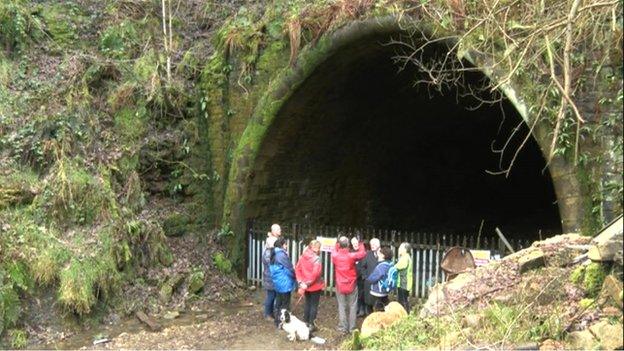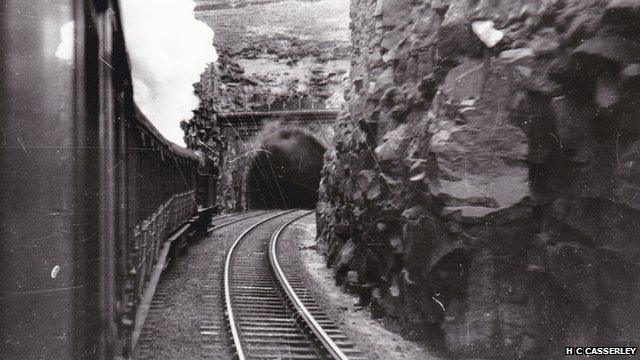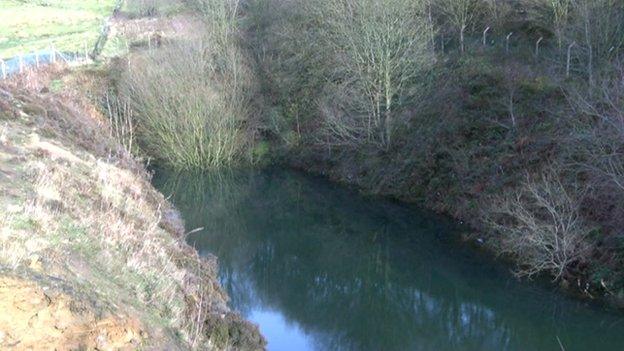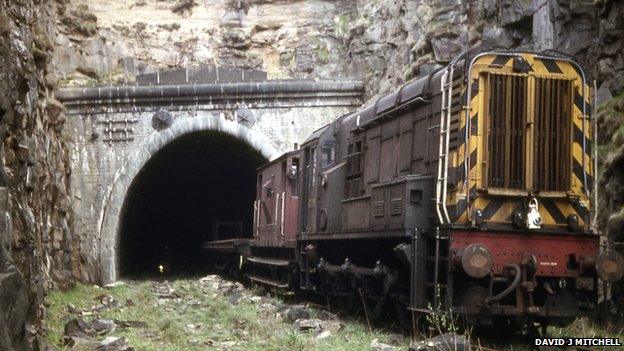Queensbury Tunnel could be Europe's longest underground cycleway
- Published

Campaigners fear the tunnel will be sealed off and lost as an opportunity for cyclists
Europe's longest underground cycleway could be built in West Yorkshire if campaigners succeed in their aim to get an abandoned rail tunnel converted into a cycle path.
But it's a race against time because Queensbury Tunnel between Bradford and Halifax needs expensive repairs and there are fears its owners might fill it with concrete.
Campaigners in the Pennine village of Queensbury came up with the idea to encourage cyclists to get on their bikes.
They want to reopen the abandoned railway tunnel that runs deep under the village as a cycleway which, at just over 1.4 miles (2.3km), would be the longest underground bike route in Europe.
It would avoid steep, traffic-clogged roads and provide a direct link between Bradford and Halifax.

The Great Northern Railway's Queensbury Tunnel closed in 1956
But, like cycling on the surrounding hills, the challenge is also a steep one. Queensbury Tunnel has not been used by trains for almost 60 years, it's flooded in parts and in danger of collapse.
The campaign is backed by cycle charity Sustrans which has already converted parts of the old Great Northern Railway line that approached the tunnel into a popular cycling trail.
The Great Northern Trail crosses Thornton Viaduct - another structure once believed to be beyond reuse.
Dave Stevens from Sustrans, external said: "That's been a success, yet they said it would never happen.
"The tunnel's not going to happen tomorrow, but if you want to build a cycle route from Bradford to Halifax it's the ideal way to do it because you miss out the hill.
"We've delivered a similar project in Bath, opening a mile-long tunnel there, so technically it's not impossible."

The Halifax end of the Queensbury Tunnel is submerged under 40ft of water
He admits, however, that it would be a complex project, not least because the Halifax end of the tunnel is submerged under 40ft (12m) of water.
Queensbury Tunnel used to be owned by British Rail Board Residuary Ltd but when that organisation was wound up in 2013 ownership transferred to the Highways Agency.
The agency has confirmed it is making plans to carry out maintenance work at the tunnel over the next five years, but says the work is subject to funding.
Campaigners see that maintenance programme as an opportunity to get a cycleway installed.

The track was lifted in 1963 - seven years after the tunnel's closure
Their fear is the Highways Agency will decide the tunnel is a liability rather than a heritage asset and seal it forever.
Graeme Bickerdike, a railway historian, who has written about the railway line on the Forgotten Relics of an Enterprising Age website, external, says that sealing the tunnel would be an opportunity lost.
"There are a lot of people with an attachment to this tunnel, so if the Highways Agency is going to spend £3.5m of public money on what is effectively a black hole it would be nice to think that, at the end of the day, the public could get some benefit from that," he said.
"If it's blocked up with concrete and sealed there is no benefit and that would be quite a loss historically and socially."
Later this year Yorkshire will host the opening stages of the Tour de France.
Organisers hope that bringing the world's biggest cycle race to the county will leave a lasting legacy and part of that legacy could be Europe's longest underground cycleway - a safe, dry shortcut under what is otherwise a thigh-burning climb.
- Published11 February 2014

- Published12 August 2013
